Public speaking is easily one of the most anxiety and fear-inducing activities a person can do. Just the thought of speaking in front of a group can be the cause of sweaty palms, the knocking of knees and a gut-wrenching case of nausea. As a matter of fact, public speaking tops death on the “stressful things to do” list. Think about that for a bit. Most people would rather to die rather than speak to an audience. Perhaps a wee bit extreme, but true, nonetheless.
But, for a writer, getting up in front of a crowd can be one of the most powerful marketing tools in their arsenal. And, contrary to popular belief, it can also be a lot of fun.
Consider these points when it comes to speaking:
You’re The Ipso Facto Expert Because You’re The One Holding The Microphone
The person up front becomes the center of attention. The audience came there to see them, or some people were at least coerced into listening to them in return for a meal and maybe some networking opportunities.
The speaker at an event is generally seen as an expert. Ideally, they are. Sometimes they’re not (and we’ve all been through that less-than-captivating exercise). Writers are often uniquely positioned for public speaking. Their writing experience can give them an expertise that other speakers may not and here’s why.
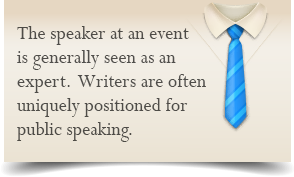 Writers write about stuff. In the course of that writing they usually conduct research into their topic. That research can provide them with the ammunition for a talk. A writer may not be an expert on a topic before writing about it but they often are afterward. Once a writer has some topical ammo, presentation and speaking delivery skills can be learned.
Writers write about stuff. In the course of that writing they usually conduct research into their topic. That research can provide them with the ammunition for a talk. A writer may not be an expert on a topic before writing about it but they often are afterward. Once a writer has some topical ammo, presentation and speaking delivery skills can be learned.
Give some thought to what you know. More than likely, there are some topics you know quite a bit about. When we know stuff, career or industry stuff, technical stuff, life stuff, etc. we tend to think, “Well, geez, everybody know that…” The reality is, they probably don’t. Even if they do, many people will sit and listen to somebody for validation of what they already know. Humans are funny that way.
What topics have you written about? Do you have some articles or blog posts that are particularly popular? Perhaps you’ve written a book or two. Those topics can become your starting point.
For example, a writer friend mine wrote a book about women’s contribution to the World War II effort. The writer didn’t contribute any efforts to the war. Yet, she can certainly speak for thirty minutes or even an hour about the topic. Odds are, like my friend, you have written on many topics that can be adapted for a presentation.
Prepare To Add Value
Preparation is key to delivering a talk with some value to the audience. Just like writing a book or an article, research your topic and do some fact checking. One caveat, however, is if you say something that’s not quite right, somebody in the audience will call you on the carpet in a demonstration of them knowing more than you. Humans are funny in that respect, too.
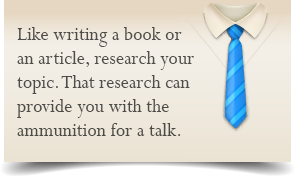 Beyond that, for those who are new to speaking, there is the more than remote possibility that you’ll get up on stage, look out over the audience … and draw a complete blank. That’s generally a bad thing unless your presentation happens to be about the virtues of mime. Care and diligence in preparation helps to avoid that little faux pas.
Beyond that, for those who are new to speaking, there is the more than remote possibility that you’ll get up on stage, look out over the audience … and draw a complete blank. That’s generally a bad thing unless your presentation happens to be about the virtues of mime. Care and diligence in preparation helps to avoid that little faux pas.
How you prepare may differ from the next gal or guy. That’s okay. Just be sure you know your stuff. Some folks like to draft their presentation in speech form; others have a list of highlights or “talking points” and the more adventurous prefer to just “wing it.” The trick is to find a way that works for you. You might prepare by rehearsing in front of a mirror or a test subject, typically a friend or loved one who is unlikely to throw tomatoes. Audio recording your oratory can also be a good idea.
The Q&A Session
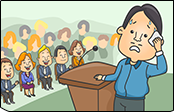 Most speaking engagements have a question and answer period at the close of the presentation. So, prepare for questions. You can prepare for the obvious ones. There are always predictable queries. There will probably be someone who, out of malice or innocence, will throw you an oddball question. If it’s something you don’t know, say so. That’s okay. You’re not omniscient, after all. But, follow it up by saying you’ll find out and, if the person will see you after the presentation, you’ll get their contact information. Be careful with this, though. If it’s a large crowd, you might just get a lot of people lining up to see you afterward in hopes of you answering their question, too. It may be a better idea to say that you’ll post the info on your blog, site or other, more public, outlet. The Audience Chose To Hear You Talk. They May Have Even Paid For The Pleasure.
Most speaking engagements have a question and answer period at the close of the presentation. So, prepare for questions. You can prepare for the obvious ones. There are always predictable queries. There will probably be someone who, out of malice or innocence, will throw you an oddball question. If it’s something you don’t know, say so. That’s okay. You’re not omniscient, after all. But, follow it up by saying you’ll find out and, if the person will see you after the presentation, you’ll get their contact information. Be careful with this, though. If it’s a large crowd, you might just get a lot of people lining up to see you afterward in hopes of you answering their question, too. It may be a better idea to say that you’ll post the info on your blog, site or other, more public, outlet. The Audience Chose To Hear You Talk. They May Have Even Paid For The Pleasure.
Your audience wasn’t corralled into seeing and hearing you. They probably weren’t paid, either. In fact, they may have paid to attend. It was their choice to attend your speaking event. This little bit of information can help you get over your fear.
It’s important to adopt (and believe) the attitude that you bring real value to the audience. You bring information they wouldn’t have received elsewhere … at least not by you.
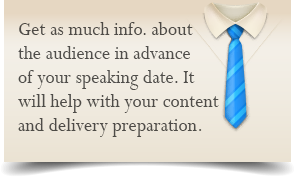 That brings up the element of personality. Only you can provide that information in your voice, with your style of delivery. There can be two speakers talking about the same subject, yet the delivery is completely different. One might be energetic and memorable. Another might be utterly dry and boring. Try not to be the latter.
That brings up the element of personality. Only you can provide that information in your voice, with your style of delivery. There can be two speakers talking about the same subject, yet the delivery is completely different. One might be energetic and memorable. Another might be utterly dry and boring. Try not to be the latter.
Along with personality, there is the absolute need to know your audience. Who are they? What’s important to them? What yanks their chains?
For example, I do a presentation about email marketing for small business. I deliver that presentation in a different manner for those already in business than I do for those who are not in business yet. Their needs are different. Get as much information about the audience well in advance of your speaking date. It will greatly help with your content and delivery preparation.
Share Stories with the Audience
From a gathering around the ‘ole campfire in front of the cave, to a group of ancient Greeks sitting at Aesop’s feet, right up to the modern day, storytelling is a fundamental method of human communication.
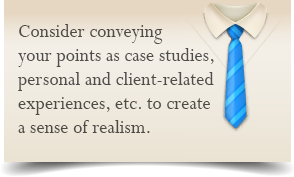 Stories allow the audience to put themselves into characters or at least relate to them. They can help to make a complex subject easy-to-understand. And, they’re entertaining. That is, hopefully they are, at least.
Stories allow the audience to put themselves into characters or at least relate to them. They can help to make a complex subject easy-to-understand. And, they’re entertaining. That is, hopefully they are, at least.
Consider conveying your points as case studies, personal and client-related experiences, etc. State the problem, the solution and the result, when possible. I tend to do this often in my presentations. It makes my talk easier since they’re my experiences, my colleagues’ or client’s.
Personal experiences and stories bring a sense of realism to a presentation. Many in your audience will be able to relate experiences in their own adventures and that helps your point hit home and be memorable.
A Speaking Engagement Brings With It Promotional Activities To Get The Word Out
Speaking engagements bring with them a promotional shot in the arm for the speaker. In addition to your own promotional efforts, the sponsor(s) of the event will also be promoting it. They’ll certainly add a bit about the event on their site, blog or both, promote it on social media, email marketing and other Web-based channels.
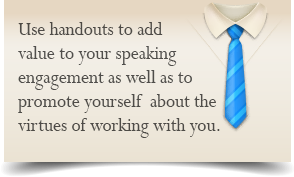 They may also send out news releases and get additional press and broadcast coverage before, and sometimes at or after the event. That can be a goldmine for the speaker. It gets their name out to a much wider audience at little and usually no cost. I’ve been fortunate to have several radio, TV and Internet-based interviews come about as a result of my speaking engagements.
They may also send out news releases and get additional press and broadcast coverage before, and sometimes at or after the event. That can be a goldmine for the speaker. It gets their name out to a much wider audience at little and usually no cost. I’ve been fortunate to have several radio, TV and Internet-based interviews come about as a result of my speaking engagements.
As an added bonus, your presentation may be recorded for distribution after the event. It might even be sold as mp3, video or printed material. If you’re one of the fortunate ones, you might get a cut of the profits.
Handouts are also a good idea to create for your speaking engagement. These might be a list of highlights, resources, brochures and/or other educational material. I often make CDs with my presentation slides, links to informational sites, articles I’ve written on the topic, etc. The CDs have a custom designed label and jewel case insert. I’ve also created private websites with similar information for the audience. If you choose to add handouts to your speaking toolbox, you might also include some promotional materials about the virtues of working with you.
It’s Showtime!
A speaking engagement is, for all intent and purpose, showbiz. At least the best ones contain a showbiz element. Have fun with it and your audience will too. Incorporate some humor and try, as best you can, to have each audience member leave with the sense that you were talking just to them. That’s easier said than done, but hardly impossible.
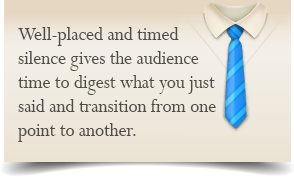 Body language counts for a lot. Are you somewhat animated or just standing there? Move around the stage or spot where you’re speaking. Own that space. Don’t overdo it, though. Use facial expressions and gestures to punctuate a point, but try to keep it natural. I’m of Italian heritage, so hand gestures are somewhat genetic, at least so it seems.
Body language counts for a lot. Are you somewhat animated or just standing there? Move around the stage or spot where you’re speaking. Own that space. Don’t overdo it, though. Use facial expressions and gestures to punctuate a point, but try to keep it natural. I’m of Italian heritage, so hand gestures are somewhat genetic, at least so it seems.
Tactics, such as nodding when you want the audience to agree, can also be employed. Unless you’re talking about some rather grim topic, remember to smile. Adding in a bit of humor here and there helps. A simple, appropriately placed smile can go a long way toward connecting with your audience.
On the other hand, silence is yet another speaking tool. While that may sound like a dichotomy in terms, it really isn’t. Well-placed and timed silence gives the audience time to digest what you just said, transition from one point to another or add impact. Silence can be tricky, though. You want a bit of silence for effect, but not so long as to create a void and have the audience thinking you’ve forgotten what to say. Also, a lengthy silence might give the audience a false cue that it’s the end of your presentation.
Eye Contact is Paramount
As mentioned, some speakers have a dreaded sense of blind fear when they get up on stage. To overcome this, try looking at the back of the room, just over the tops of the audience’s heads. When done right, it will seem as though you’re looking at them. Another tactic is to begin your presentation by scanning the audience from left to right and then back to the middle.
 Make eye contact with individuals during the presentation. In as much as eyes are called the windows to the soul and can add to your credibility, eye contact is paramount to gaining the trust of your audience. You want to make an authentic connection with them … individually as much as possible. Sure, that can be a tough thing to do unless you’re speaking to a small group. But, you can create the sense of a connection. Plus, you can have more of a sense that you’re speaking to one person at a time and make the experience less overwhelming.
Make eye contact with individuals during the presentation. In as much as eyes are called the windows to the soul and can add to your credibility, eye contact is paramount to gaining the trust of your audience. You want to make an authentic connection with them … individually as much as possible. Sure, that can be a tough thing to do unless you’re speaking to a small group. But, you can create the sense of a connection. Plus, you can have more of a sense that you’re speaking to one person at a time and make the experience less overwhelming.
Try to make eye contact with audience member for about three to five seconds or so. This is roughly the amount of time for eye contact during a normal, one-on-one conversation. If you engage people for longer they’ll tend to feel uneasy and uncomfortable. At worse, you’ll appear creepy. Conversely, if you don’t engage them for enough time, you can come off as less than trustworthy.
Wrapping Up
When I was young, the idea of speaking to a group terrorized me to the point of nausea. Now days, I rather enjoy it. Speaking gives me an opportunity to connect and share my knowledge and experience with a lot of people at one time. I’ve had the opportunity to meet lots of interesting people and travel hither and yon.
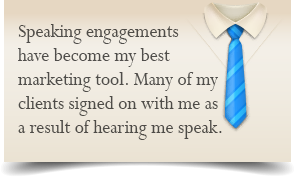 I started out small. My first speaking experiences were at schools and a few rather small business gatherings. It was easy to speak to students. The small business events were also easy. It was much more like a laid back conversation with a small group of folks. I didn’t start speaking to audiences of hundreds until a few years later. I grew into it, for the most part. You will too.
I started out small. My first speaking experiences were at schools and a few rather small business gatherings. It was easy to speak to students. The small business events were also easy. It was much more like a laid back conversation with a small group of folks. I didn’t start speaking to audiences of hundreds until a few years later. I grew into it, for the most part. You will too.
Speaking engagements have become, by far, my best marketing tool. Many of my clients signed on with me as a result of hearing me speak. Although I don’t do as many these days, they’re still a viable tool. In days gone by, I do as many as 21 in ten months. I’d pretty much speak to whoever would listen. It was also more than a bit exhausting. I tend to be a bit more selective these days.
In wrapping up, adding public speaking to your marketing toolbox can be a serious publicity shot in the arm. It may even become an additional source of revenue. Considering that speaking fees can range from several hundred to many thousands of dollars, speaking can become a major source of revenue for those willing to put in the practice, time and effort.
Resources for Public Speakers
Tap into a local Toastmasters [ www.toastmasters.org ] group to help hone your skills. Although there is a cost, it’s well worth the investment for many folks. Toastmasters tends to be rather structured with speeches. That’s not a bad thing and their structure can aid some people.
Another resource are Dale Carnegie courses [ www.dalecarnegie.com ]. Carnegie offers courses in leadership, communications, presentation skills and more.
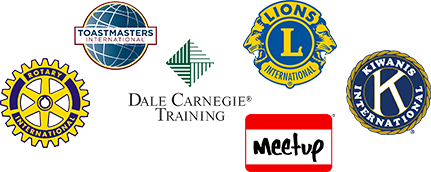 When it comes time to seek out a gig, there are plenty of business groups that are starved for speakers. Rotary [ www.rotary.org ] comes to mind, as do Kiwanis [ www.kiwanis.org ] and Lions Clubs [ www.lionsclubs.org ].
When it comes time to seek out a gig, there are plenty of business groups that are starved for speakers. Rotary [ www.rotary.org ] comes to mind, as do Kiwanis [ www.kiwanis.org ] and Lions Clubs [ www.lionsclubs.org ].
Local chambers of commerce, trade groups/clubs and similar organizations are also prospects for speaking opportunities. Check into smaller conventions, conferences and similar events as well. Meetup.com [ www.meetup.com ] is yet another resource for finding speaking opportunities.
Meeting planners sometimes tap into the various websites that list speakers along with speaker bureaus. A Web search will yield several. Some are free and other charge a fee. Also, several states have their own speaker bureaus.
Additional Online Resources:
- APB Speaker Bureau [ www.apbspeakers.com ]
- Speaker Resources [ www.speakerresource.com]
- Speaker Zone [ www.speakerzone.com ]
About the author:
Neil Tortorella is a graphic designer, writer and marketing consultant with over thirty years experience. He is the author of Starting Your Career As A Freelance Web Designer, Starting Your Career As A Musician and The Freelance Writer’s Business Book. Tortorella is a frequent speaker at conferences and business events. His writing and consulting site can be found at www.neiltortorella.com.
Also by Neil Tortorella:
1. How to Generate High Quality Referrals for Your Writing Business (article)
2. Avoid These 10 Common Freelancing Traps to Run a More Successful Writing Business (article)
3. How to Get Tantalizing Testimonials from Your Clients (article)
4. Copyright and Usage Rights for Freelance Writers (article)
5. How to Qualify Potential Clients for Your Freelance Writing Business (article)
6. Money Management Tips for Freelance Writers (article)
7. Retirement Planning for Freelance Writers (article)



